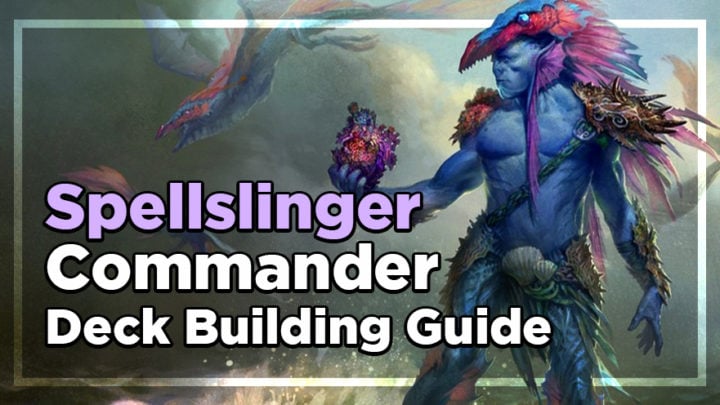Few Commander strategies have been around as long as Spellslinger, and even fewer have remained viable. It’s like a beautiful house of cards, with each piece leaning on another to become something immense. Watching an experienced player piloting a Spellslinger deck can be a fascinating sight to behold; from the rapid decisions to the almost psychic knowledge of their library’s contents, there’s no other form of Magic that comes close. It’s no surprise that the recent Prismari Performance preconstructed deck was a Spellslinger one: every aspect of the archetype has an artistic and expressive feel to it, so it fits the bill perfectly.
If you’ve ever wondered what goes into making a Spellslinger deck, you’re considering making one, or you’re looking to make your current deck leaner and more focused, then this is the guide for you. I’ll explain the definition of a Spellslinger deck, why you’d want to play one, and some important considerations when designing or building your own.
What Is A Spellslinger Deck?
Spellslinger decks can take all manner of forms, but they all follow one core tenet: to gain advantage through the use of instants and/or sorceries. This can be achieved in a number of ways, from gaining incidental value from each spell, to chaining several together for a massive payoff. Generally speaking, the commander is usually pivotal in the game plan, often hinting toward the specific style of Spellslinger.

Traditionally, Spellslinger decks almost always include either blue or red, and often both; these colors contain the most potent enablers and payoffs for the archetype (there aren’t really any green Young Pyromancers or white Treasure Cruises, for example). They also tend to contain many cheap spells that often draw cards, which affords them a consistency often absent from many singleton decks.
Why Play A Spellslinger Deck?
There are many reasons why you might want to sling spells. If you want a consistent deck that doesn’t feel too “samey,” if you enjoy extensive use of the stack, or even if the combat phase just doesn’t do it for you, then you might be a Spellslinger.
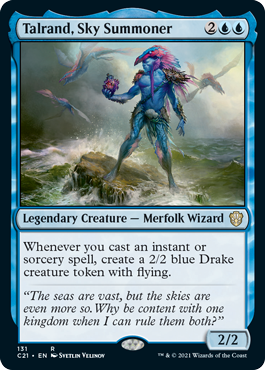
If you’re coming from another format like Modern or Historic, you might notice some analogues between decks. Grapeshot, Arclight Phoenix, Young Pyromancer, and Counterspell all fit comfortably under the Spellslinger umbrella; if these cards appeal to you, then you might enjoy the archetype.
Spellslinger has been a historically well-supported archetype, with every set providing at least a couple new options to choose from. You’re truly spoiled for choice; I regularly have trouble cutting out the last 30 cards from my brews, compared to the last five or six cards with other strategies. This also means that decks are extremely customizable, making it effortless to make your deck your own.
Top 5 Deck Building Tips
With all of these different directions you can take your deck, it can become a daunting task to hone in on something concrete. Here are my top considerations when building a Spellslinger deck; these should help you to make decisions on what to focus on and how to streamline your deck.
Proactive Or Reactive
One of the biggest decisions you need to make when building a deck is to choose between a proactive or reactive game plan. There are exceptions to this, but most decks will fit into one of these two types. The type of game plan you choose will often influence your choice of commander, and vice versa.
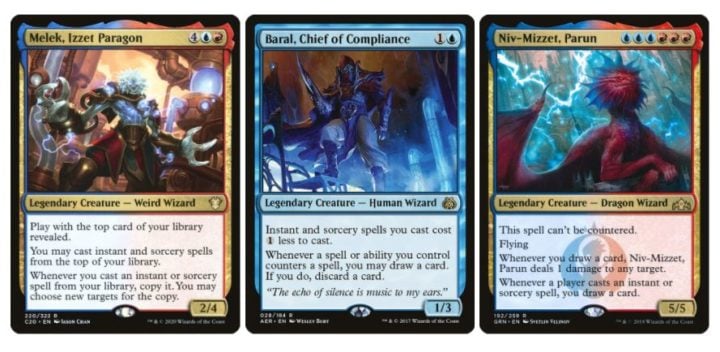
Proactive decks look to consistently advance their game plan, often forcing opponents to either slow them down or catch up. These decks tend to tap out more often, and usually have a greater number of threats. Proactive Spellslinger decks would usually run more copy spells (like Doublecast) and direct damage, but fewer counterspells. Storm decks are the most well-known example of a proactive Spellslinger strategy, and Melek, Izzet Paragon is one of the most popular proactive Spellslinger commanders.
Reactive decks are typically the safety valve, well-equipped to prevent other decks from getting out of hand. They usually operate more at instant speed, ready to stop any deck that poses a threat. Reactive Spellslinger decks are more likely to run an abundance of counterspells or removal, and they’re most comfortable in playing the long game. They’re most likely to win through attrition or by landing a single threat and protecting it, rather than through trying to brute force a combo. Control decks fit under this category, with Baral, Chief of Compliance being an (in)famous example of a reactive commander.
As I mentioned already, some decks are capable of filling both roles — playing an early control game until they see an opening, then closing the game quickly and efficiently. They tend to be decks whose commander can quickly facilitate a change in gears, either through a snowball effect or as part of a combo. Niv-Mizzet, Parun is the textbook commander for this style: you control the early turns with counters and removal, then use those spells to protect Niv during a Curiosity combo finish.
Additional Payoffs
Many Spellslinger decks rely on their commander as the primary win condition. While it’s great to have constant access to your win condition, it can be risky to rely solely on them to win. If your commander is removed one too many times — or one of your opponents has a Drannith Magistrate on board — you can effectively be locked out of winning. That’s why it’s so important to have backups within the 99 to take up the mantle when needed.
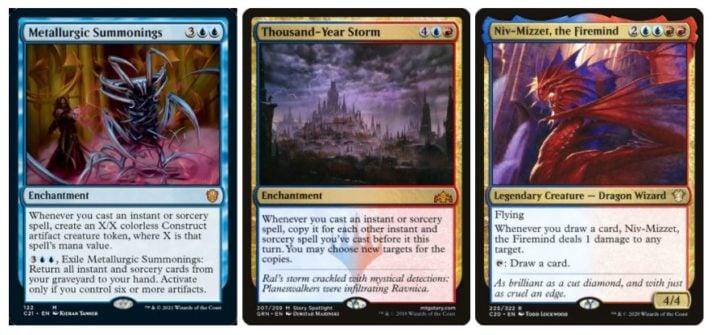
Thankfully, Spellslinger decks are spoiled for choice when it comes to payoffs. If your commander is Talrand, Sky Summoner, for example, you can run Murmuring Mystic or Metallurgic Summonings as additional token generators. Thousand-Year Storm is a great replacement for Melek, Izzet Paragon; Niv-Mizzet, Parun can simply run Niv-Mizzet, Dracogenius and Niv-Mizzet, the Firemind for added redundancy.
The great thing about these “backup commanders” is that they’re good cards by themselves, but they can become obnoxious when paired with your commander. Multiple versions of your commander means more value per spell cast, and greater resiliency to spot removal. This is a solid way to go over the top of other decks, particularly if you don’t want to include combos.
Minimum Spell Count
This might seem like an obvious one, but in order for Spellslinger decks to operate effectively, they need to have a critical mass of instants and sorceries. Many decks run a decent balance of creatures, enchantments, and artifacts, but the more of these you have, the fewer instants and sorceries you’ll draw.
Some cards, like mana rocks, simply can’t be avoided, but there are ways to increase the spell count without reducing functionality. I’ll use my Talrand, Sky Summoner deck as an example:
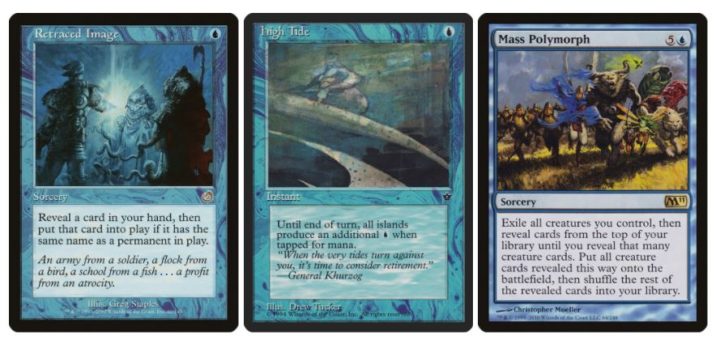
I use two spells in this deck as replacements for mana rocks: Retraced Image and High Tide. Retraced Image allows me to put an Island from my hand onto the battlefield, and High Tide gives me an enormous temporary burst of mana. Mass Polymorph is my usual win condition: I purposely only run three creatures in the 99, so when I cast this spell, I can generate infinite mana and spell recursion through Peregrine Drake, Deadeye Navigator, and Archaeomancer. It can be risky, but it’s incredibly consistent, and it allows me to greatly reduce my creature count. It’s changes like these that allowed me to squeeze in a whopping 52 instants and sorceries!
My Talrand deck is certainly on the extreme side of things, but there are many little changes you can make to improve your spell count, no matter who your commander is. Kalamax, the Stormsire greatly prefers Roiling Regrowth over a Commander’s Sphere, for example. This is actually one of my favorite parts of brewing up a Spellslinger deck — I love nothing more than finding new cards to add to my creations!
Are Cost Reducers Really Worth It?
This is possibly my most controversial opinion in Magic (and that is really saying something). It’s almost sacrilege to suggest the removal of cards like Goblin Electromancer or Sapphire Medallion in these strategies. But as powerful as they may be, they could actually prove to be extremely inefficient.
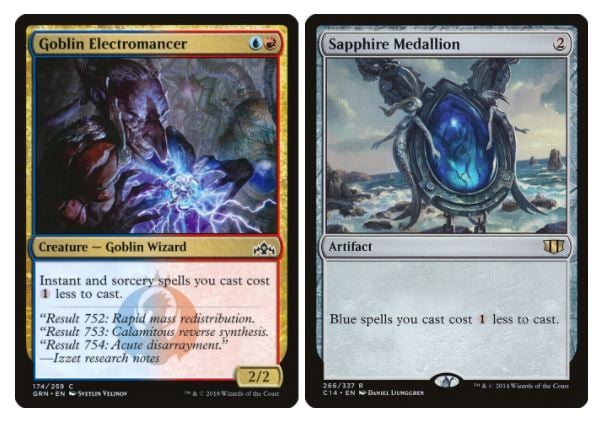
Many Spellslinger decks look to cast several cheap spells, so these creatures that reduce the cost of them seem like a great addition, right? Well, not really. There’s no denying the virtual ramp capabilities of cards like these, but they often don’t do enough. The majority of Spellslinger decks already run extremely efficient instants and sorceries, often costing just one mana.
Take Kykar, Wind’s Fury, for example. According to EDHREC’s average deck for Kykar, Goblin Electromancer will only reduce the cost of 20 spells. That’s less than 30% of the nonland cards in the deck, and just over 50% of the instants and sorceries. We can easily replace Electromancer with another spell that will help to either further the game plan or increase consistency.
I’m not saying we should remove all cost reducers from Spellslinger decks entirely, but I do believe they see a disproportionate amount of play relative to their impact.
Combos Are Your Friends
Let’s be honest: combat damage just won’t cut it here. If you’re spending a lot of your time slinging spells, you’re not committing to the board as heavily as many other strategies. This often makes it hard for Spellslinger decks to close out the game in a reasonable time frame. Therefore, I recommend that most Spellslinger decks contain some form of combo, even if it’s just a four-card combo with no tutors. More players would prefer an efficient end to their games to a slow death at the hands of a Young Pyromancer’s Elemental tokens.
Spellslinger combos vary wildly — there’s the aforementioned Niv/Curiosity combo; Ral, Storm Conduit copying a copy spell infinite times; even mass spell-casting like Mizzix’s Mastery. The beauty of these combos is that there’s almost certainly one that will work well in your deck, but you need to choose wisely. There’s not much point in putting The Locust God, Skullclamp, and Ashnod’s Altar in your Melek deck, for example, as you need to have all the pieces at once to get value out of any of them.

Not all Spellslinger decks need to go infinite, however. Many decks, like Sakashima of a Thousand Faces and Krark, the Thumbless, lend themselves to casting an absurd number of spells in a turn. Adding the pieces for an infinite combo wouldn’t be a bad thing, but there are plenty of other powerful spells that work just as well with the commanders, like Aetherflux Reservoir or Sentinel Tower.
In Closing
I hope these tips help you decipher the often murky and perplexing waters of Spellslinger strategies in Commander. I have a great love for the archetype, and it’s one that’s often misunderstood as “just another pile of spells.” This is one of Magic’s deepest forms of play, and every deck is far greater than the sum of its parts.
While this guide was designed to help you learn how to build Spellslinger decks, know that there is no “wrong” way to build one. If something you enjoy in your Kess, Dissident Mage deck doesn’t align with some of these points, for example, don’t let that stop you from doing your thing. Every deck is a form of self-expression, after all!

Scott is an Irish content creator and the Head of Budget Magic for the Izzet League. He focuses on affordable decks in Pioneer, Modern, and Pauper, particularly ones that stray from the mainstream. When he’s not writing about his favorite decks, he can be found talking incessantly about them on Twitter and on The Budget Magic Cast.

